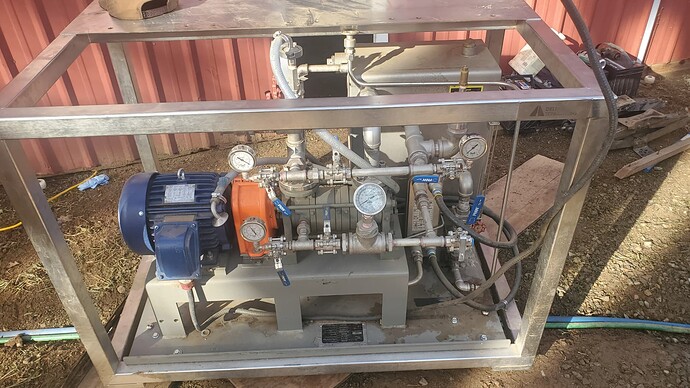Has anyone used like a Liquid Ring Vacuum Pump that is designed to handle hydrocarbons to keep the entire closed loop extraction under vacuum for increasing your recovery times at lower temperatures. Wondering if that would work to speed up recovery times on a passive system.
Because the deeper vacuum you pull the lower temps you will need to keep the solvent a liquid.
Chillers ain’t cheap to buy or run at those temps.
I think what you’re looking for is called a recovery pump.
why would I want to do THAT…
With a vacuum pump like that would you be to cold boil and recover hydrocarbons without having a solvent recovery pump.
Yes, and the goal is to recover faster ![]()
Which == decreasing recovery TIME.
== increasing recovery RATE (which is what you presumably meant).
you will either need to condense at vacuum (which means colder), or pass the solvent THROUGH the pump.
If your pump is up for that sort of nonsense and won’t contaminate your product, then yeah, give it a go.
Doesn’t seem like the right tool, but using what you’ve got can teach you all kinds of fun stuff.
I agree. In my experience, liquid ring pumps struggle to discharge fighting any head pressure, they prefer a low head hydronic design. Liquid ring pumps also struggle with fighting cavitation, which when using LPG, its easy to phase change in transfer or feeding. Temperature control would be critical at all points.
Since you cannot discharge to a atmospheric vented tank (similar to ethanol), you might need to add another heat-exchanger between the pump discharge and solvent tank to help with pressure drop.
Vacuum is key for recovery of solvent with higher bp’s, but with light hydrocarbons, they naturally want to be a gas, so we just aid that. There are also benefits to running a positive pressure recovery unit.
cyclopath had a great point, play with it and see what comes up. The most beneficial changes I have made to design and equipment has come during testing, not behind a computer running calcs lol.
Let me know if I can help!
The liquid ring pump is a vane pump where the vane is fixed, and is sealed through the liquid that flows through the pump. The liquid can be water or oil but must be viscous enough to allow whatever you are trying to remove from the “chamber” to mix with the pump liquid. It doesn’t have to be mixable, just viscous enough to flow. The “mix” itself must be vapor, not liquid. If removing a solvent, as you decrease the pressure, you lower the boiling point of the solvent. Works to your advantage for a temperature sensitive product.
The liquid ring pump pulls a vacuum, and the pump will suck the vaporous solvent, mix (blend) it with the pump liquid, and pull only the vapor from the chamber. The removal rate is dependent on the vapor pressure of the solvent, e.g. where the solvent changes from its liquid state to a vapor state, a temperature/pressure relationship. The lower the pressure, the lower the vapor point.
As you go from a liquid to a vapor, the amount of cubic feet in vapor increases dramatically as you lower the pressure. The deeper in vacuum, the more cubic feet per pound of “mix”, and you have to do more “work” as you are increasing the number of cubic feet of vapor as you decrease the pressure. So the optimum pressure would be just below the vapor point as that is where the vapor is densest.
The more CFM *cubic feet per minute) of pump capacity, the faster you can pull the vapor.
There is another issue as well: e.g. bound vapor versus “free” vapor. It is possible that within the product, there is “bound” vapor, and this will be hardest to pull out. Vapor removal is also a function of heat as you have to change phase (liquid to vapor) and that takes a specific amount of BTU’s per pound. Heat is “added” to allow the product to change from liquid to vapor.
Lastly, when the vapor is mixed with the liquid in the pump, there is extra heat in the pump liquid, which must be removed, otherwise, the pump liquid could “vaporize” or as another post said - cavitate. This stops the functioning of the pump.
Finally, there is a problem of getting rid of whatever you are removing. It can be discharged to the air (e.g. water vapor), but if it is a chemical, it needs to be captured, e.g. through a “cold trap”.
Your are correct, vacuum would assist in recovery, and the greater the vacuum flow (not pressure), the faster you can evacuate the chamber, and remove whatever you are trying to remove. The “bound” chemicals will the longest.
Eric M.E. 650-888-5096

